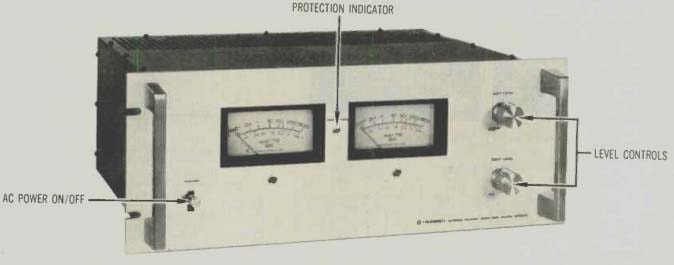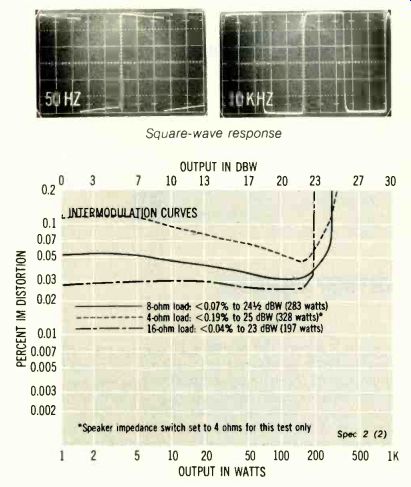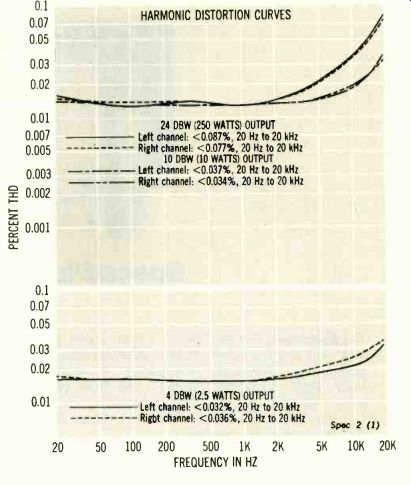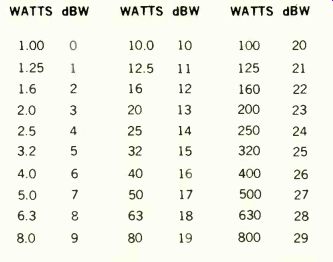
The Equipment: Pioneer Spec-2, a basic power amplifier with peak-reading output meters, in metal case. Dimensions: 18 7/8 by 7 3/8 inches (front panel), 17 1/2 inches deep.
Price: $900. Warranty: "limited," two years parts and labor.
Manufacturer: Pioneer Electronics Corp., Japan: U.S. distributor: U.S. Pioneer Electronics Corp., 75 Oxford Dr., Moonachie, N.J. 07074.
Comment: There is something about testing a super-amp that leaves us slightly frustrated, as though the amp were laughing up its sleeve at us. Consider the Pioneer Spec-2. CBS labs puts it through very thorough testing, and the amp just breezes along doing what it is supposed to do, of ten with a good deal to spare. Then we connect it to some loudspeakers, feed a music signal to it, and listen at a level that would drive most people from the room. Nothing untoward happens. Next we connect a second pair of speakers in parallel, bringing the total load to 4 ohms (and some times less)-and neglecting, we might add, to reset the back -panel switch that lowers the supply voltage to ensure safe operation with such a load-and feed a signal in again. Still no misbehavior. The front panel meters show that we are approaching half power on peaks, and this monster (which has no fan) doesn't even get warm.
Outflanked on the high -power front, we make a tactical retreat to the opposite end of the power spectrum and play music (with loudness compensation) at levels at which :he peaks are all less than 0 dBW (1 watt). The amp remains as clean as a whistle. And when the volume is turned down completely, not a trace of noise is audible until we bring an ear to within an inch or so of the tweeter.
The lab data are in accordance with the excellent performance in the listening test. Worst-case total harmonic distortion at the rated 24-dBW (250-watt) per channel out put is 0.087% at 20 kHz. IM distortion at full power is less than 0.051%. Both forms of distortion decrease as output diminishes toward 23 dBW (200 watts), remaining at a plateau down to levels well below 0 dBW. That CBS's measurement of the damping factor does not precisely confirm Pioneer's specification is probably attributable to the rigor of CBS's testing method and is of no practical importance in performance. More to the point, Pioneer's modest de sign value suggests that the amp is clean in open-loop operation and that negative feedback has been used simply to make a good thing better. We would not expect the Spec-2 to have transient distortion problems and in fact heard nothing we can attribute to this phenomenon.
Signal-to-noise ratio, at 108 1/2 dB (equivalent to a noise level of -84 1/2 dBW) is excellent. In practice, since the gain of the amp (1.6 volts in for full output) is so high, its level controls can be cut back and the noise lowered further still.
Frequency response can be drawn with a ruler through the audible region and is down only 3/4 dB at 10 Hz and 100 kHz. Robust in its construction and appearance as well as in performance, the Spec-2 can be rack -mounted at the user's option. Unlike some rack-mount amps, it has regular pin-jack inputs; the speaker terminals are hefty three way (for bared wires, large spade lugs, or banana plugs) binding posts.
Quite a mystique has grown up around super-amps, and some people claim to be able to hear substantial differences in sound from one model to another. We do not doubt that differences exist, but in our experience they are extremely subtle and show up only in rigorous A/ B testing.
This alone (ignoring listening tastes and applications) would militate against our trying to pick a "best" super-amp. What we can say, however, is that the sound of the Spec-2 is right there with the best of the contenders we have heard. It will not surprise us if you conclude that it is the best.
------------
Pioneer Spec-2 Amplifier---Additional Data
Power output at clipping (channels driven simultaneously)
L ch 24 1/2 dBW (280 watts) for 0.21% THD
R ch 24 1/2 dBW (280 watts) for 0.18% THD
Frequency response: ±0 dB, 20 Hz to 20 kHz
+ 0, -3/4 dB, 10 Hz to 100 kHz
Input characteristics (for rated output at full gain)
Sensitivity : Noise : S/N ratio
1.6 V; -84 1/2 dBW; 108 1/2 dB
Damping factor at 1 kHz: 46
-----------

-----------Square-wave response

-----------HARMONIC DISTORTION CURVES
-----------INTERMODULAILON CURVES
-----------
About the dBW . . .

We express output power and noise in terms of dBW-meaning power in dB with a reference (0 dBW) of 1 watt. We repeat herewith the conversion table so that you can use the advantages of dBW in comparing current products with those we have reported on in the past. You can, of course, use the figures in watts that accompany the new dBW figures for these comparisons, but then you lose the ability to compare noise levels for outputs other than rated power and the ability to figure easily the levels to which specific amplifiers will drive specific speakers -as explained in the June 1976 issue.
If you do not have that issue and would like a reprint of the full exposition, send 25¢ ( U.S.) to: dBW, c/o High Fidelity Magazine, The Publishing House. Great Barrington, Mass. 01230.
---------
Preparation supervised by Robert Long and Harold A. Rodgers Laboratory data (unless otherwise noted) supplied by CBS Technology Center
[REPORT POLICY: Equipment reports are based on laboratory measurements and controlled listening tests. Unless otherwise noted, test data and measurements are obtained by CBS Technology Center, Stamford, Connecticut, USA, a Division of Columbia Broadcasting System. Inc one of the nation's leading research organizations
The choice of equipment to be tested rests with the editors of HIGH FIDELITY. Manufacturers are not permitted to read reports in advance of publication, and no report, or portion thereof, may be reproduced for any purpose or in any form without written permission of the publisher. All reports should be construed as applying to the specific samples tested, neither HIGH FIDELITY ... nor CBS Technology Center assumes responsibility for product performance or quality.]
-------------
(High Fidelity, Apr. 1977)
Also see:
Empire 698 turntable (Equip. Profile, Apr. 1977)
ADC--Accutrac turntable (ad, Apr. 1977)